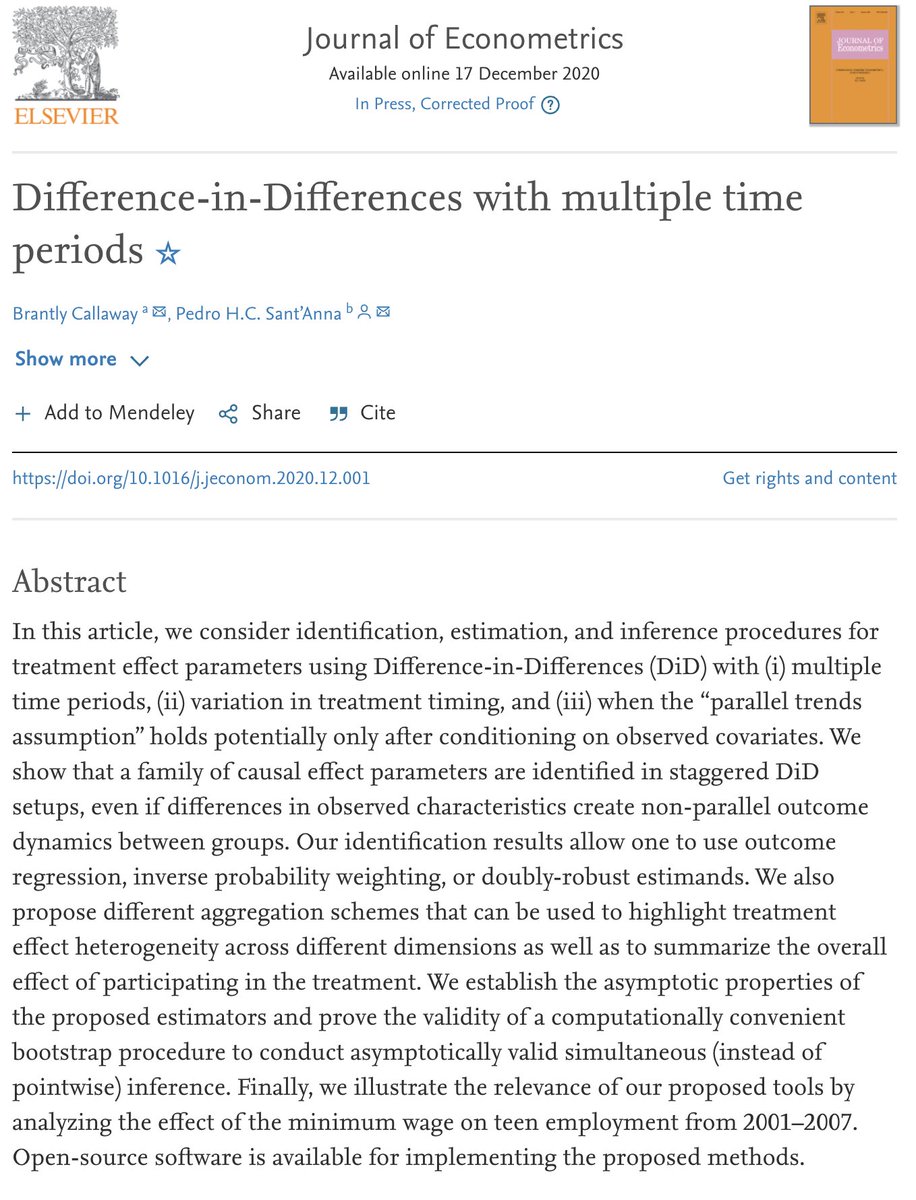 Hello #EconTwitter! I am very happy that my paper with Brantly Callaway, "Difference-in-Differences with multiple time periods", is now forthcoming at the Journal of Econometrics. https://www.sciencedirect.com/science/article/pii/S0304407620303948?dgcid=author
Hello #EconTwitter! I am very happy that my paper with Brantly Callaway, "Difference-in-Differences with multiple time periods", is now forthcoming at the Journal of Econometrics. https://www.sciencedirect.com/science/article/pii/S0304407620303948?dgcid=authorWhat are the main take aways? I will ask my daughter to help me out.
1/n
Our main goal here is to explain how one can transparently use DiD procedures in setups with (a) multiple time periods, (b) variation in treatment timing (staggered adoption), and (c) when a parallel trends is plausible potentially only after conditioning on covariates.
2/n
2/n
But why should one care? Don't we all know all these things already? Why can't we just use TWFE regressions and move on?
3/n
3/n
To answer this important question, we can run a simple simulation.
Consider 4 treatment cohorts, where units are assigned to these cohorts completely randomly.
Think of perfect DGP for DiD that looks like this
4/n
Consider 4 treatment cohorts, where units are assigned to these cohorts completely randomly.
Think of perfect DGP for DiD that looks like this

4/n
If you are interested in treatment effect dynamics, the "status-quo" procedure in the literature is to use a two-way fixed-effects linear regression model with leads and lags (with potentially binned event-times)
If you do it here, you get substantial bias!



5/n
If you do it here, you get substantial bias!




5/n
However, this is not a problem of the *design*! It is a problem of the estimation procedure!
Indeed, if one uses the DiD procedure that Brant and I propose in our paper, you get very precise event-study estimates!
This is why we insist that *TWFE IS NOT DiD*!
6/n
Indeed, if one uses the DiD procedure that Brant and I propose in our paper, you get very precise event-study estimates!
This is why we insist that *TWFE IS NOT DiD*!
6/n
Now, time to explain *HOW* we do this so our goal of making DiD tools really accessible is closer to be achieved.
7/N
7/N
With multiple time periods and variation in treatment timing, the three main points a DiD procedure needs to address are:
1) What is the parallel trend assumption (PTA)?
2) Is treatment anticipation something we need to worry about?
3) What are the parameters of interest?
8/n
1) What is the parallel trend assumption (PTA)?
2) Is treatment anticipation something we need to worry about?
3) What are the parameters of interest?
8/n
By answering these 3 questions, we specify a) which units should be used in your comparison group (e.g., never-treated or not-yet-treated), b) which pre-treatment time period should serve as the baseline comparison, and c) how you can use the data to answer your scientific q.
9/n
9/n
The main building-block of our proposal is the ATT(g,t). This is the average treatment effect at time t among the units that were first treated in time period g.
This is the parameter we aim to identify by making a PTA and a limited treatment anticipation assumption.
10/n
This is the parameter we aim to identify by making a PTA and a limited treatment anticipation assumption.
10/n
Once you are set on these assumptions, we show that you can identify the family of ATT(g,t)'s by using diff estimands based on a) Outcome-regression (OR) , b) inverse-probability weighting (IPW), and c) Doubly-robust (DR)approach.
11/n
11/n
The OR, IPW and DR estimands identify *the same* parameters, but suggest different estimation procedures.
We like the DR one because it is less "demanding" on modelling assumptions, but you are free to chose your favorite.
12/n
We like the DR one because it is less "demanding" on modelling assumptions, but you are free to chose your favorite.
12/n
Regardless of which approach on you choose, the estimation procedure always rely on subsetting your data to construct "comparisons of means". This is really the "magical" part of our approach. Subset the data to respect your assumptions. That is it! Simple, right?
13/n
13/n
Now, you may be worried that you are subsetting the data "too much" and losing precision. We hear you. That is why we also propose aggregation schemes to construct summary measures of the treatment effect such as the event-study-type parameters we talked a while back!
14/n
14/n
In the paper, we propose several different aggregation schemes that can highlight heterogeneity in different dimensions. We like this quite a bit because it allows researchers to answer different questions of interest.
And the question always come first!
15/n
And the question always come first!
15/n
In order to conduct valid inference, we also propose and justify the use of a computationally attractive bootstrap procedure that is fairly fast. Importantly, it does not rely on resampling data, so we do not run into the problem of having "few" observations per group here.
16/n
16/n
Final question: How can you actually use the tools we proposed in this paper?
Surprise, surprise! We have a R package with everything ready to go: https://bcallaway11.github.io/did/
We have examples, guidelines, documentation, etc.
We did our best to make it easy to use!
#RStats
17/n
Surprise, surprise! We have a R package with everything ready to go: https://bcallaway11.github.io/did/
We have examples, guidelines, documentation, etc.
We did our best to make it easy to use!
#RStats
17/n
In the paper, we also have an empirical application. We also discuss how to use these tools with repeated cross-section data, etc.
I will stop here, because Sofia wants to go back to play!
Thanks everyone, and please feel free to DM or email me if you have questions!
n/n
I will stop here, because Sofia wants to go back to play!
Thanks everyone, and please feel free to DM or email me if you have questions!
n/n
You can download the paper using this link (until February 2021) https://authors.elsevier.com/a/1cFzc15Dji4pnC

 Read on Twitter
Read on Twitter











